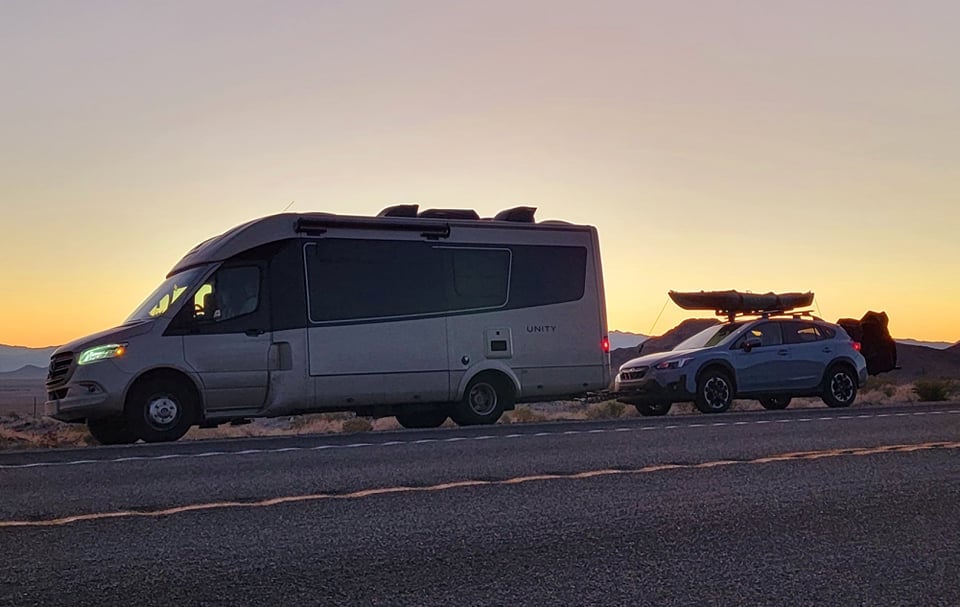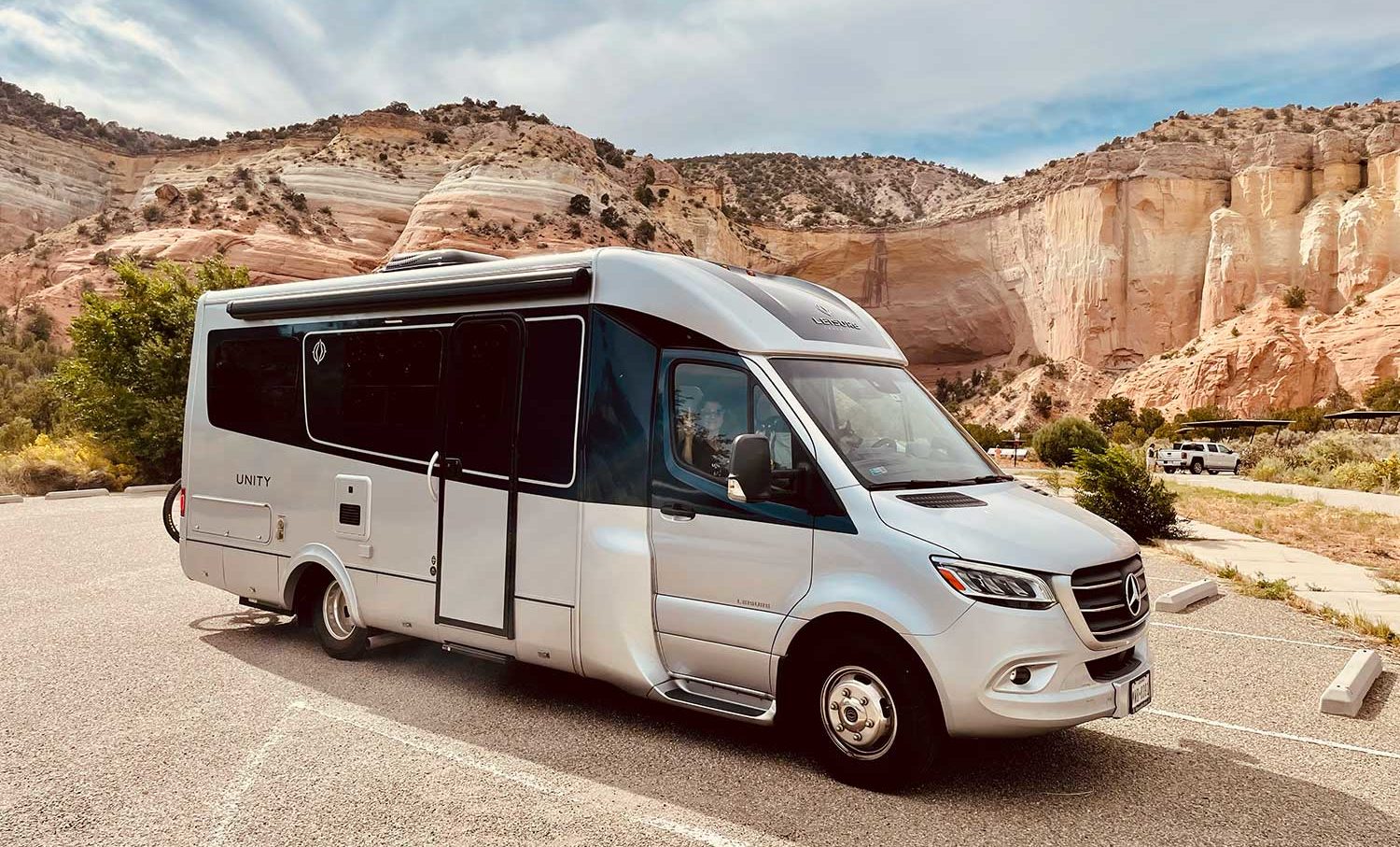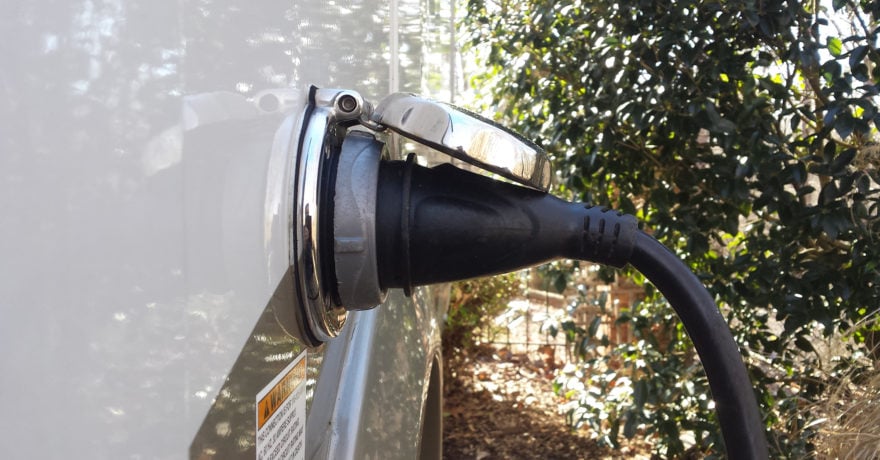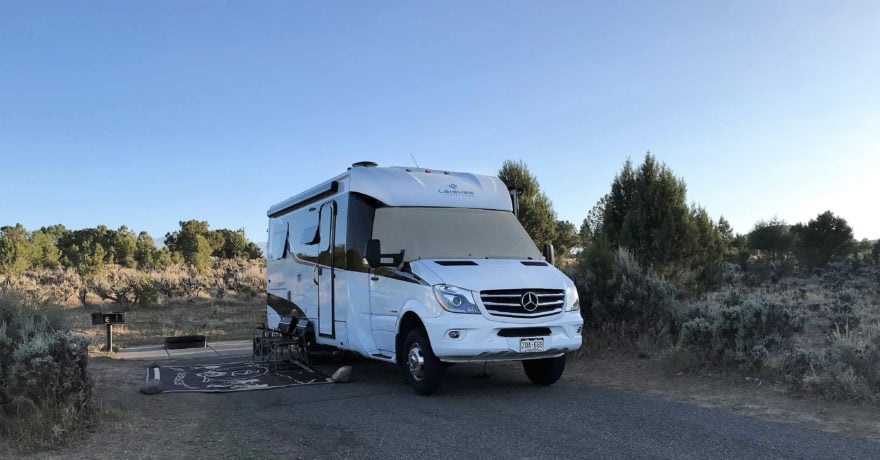Please note: The recommendations and opinions expressed in this article are those of the author(s) and are not necessarily those of Leisure Travel Vans. Please refer to your motorhome and chassis owner’s manuals, as well as hitch ratings for further information regarding towing capacities and limitations.
A premier advantage of Leisure Travel Vans is their size. While roomy and spacious, it is also extremely mobile and maneuverable. These 25-foot coaches can fit in a majority of parking lots, downtowns, and other places a towable or large Class C or Class A wouldn’t even consider going. So why would you want to consider pulling a tow vehicle along?

Some folks may want to set up their camp, plugin, and still have the freedom to go explore. But they also want to be able to leave the pets “at home in the RV” or to just simply go out to eat and run a few errands without breaking down camp. Plus, if you find that premier boondocking spot, and take off for the day in your RV, you may come back to find your space taken.
This is where having a small tow vehicle (sometimes called a “TOAD” or “dinghy”) can be a huge luxury during your RV trip. I say small because there is a weight limit that you need to follow in order to tow behind a Leisure Travel Van. Keep in mind, that not every vehicle is “flat towable”, so be sure to do your due diligence, as you can ruin your transmission or void your warranty if you flat tow a vehicle that is not deemed towable by the manufacturer. The owner’s manual of the vehicle will tell you whether it is flat towable, as well as give you the steps to put it in Tow Mode.

Weight Management for Safety is a Must
Before we discuss what I consider to be great choices for tow vehicles, let me explain weight such as GVWR (Gross Vehicle Weight Rating) and GCWR (Gross Combined Weight Rating). I am writing this as it concerns the Leisure Travel Van Unity on the Mercedes Benz chassis.
GVWR is the maximum your rig can weigh without anything hooked up to it. This takes into account the curb weight of the vehicle or what it weighs without any cargo or occupants combined with what you put in the RV including you, other people, pets, water in the tanks, and gear; plus whatever is on the hitch. Keep in mind that both axles must be within their weight ratings at all times as well.
The GCWR is the maximum your loaded rig, tow vehicle, tow bar, and everything and everyone you travel with can weigh.
Another specification to be aware of is the hitch ratings. The hitch ratings can be different between Leisure’s two chassis suppliers and some of their models. This rating could also limit your ability to tow a vehicle or certain kinds of vehicles behind your unit.
For our Unity on the Mercedes chassis, the GVWR is 11,030 pounds and the GCWR is 15,250 pounds. So let’s assume that our Unity is at its maximum allowable weight with all the people and things we travel with. The difference between the GCWR and GVWR would be the maximum weight of the TOAD, tow bar, and all the things we may put in or on the car during transport (15,250 – 11,030 = 4,220 pounds). If we travel lighter (fewer people, no water, and less stuff) the amount of weight that can be towed increases, but it is best to plan your TOAD purchase using your maximum GVWR in case you find some heavy antiques that you want to take home with you or have a friend or two that want to join you on your next trip.
It is extremely important to keep within your axel, GVWR, GCWR, and hitch tongue and pull weight ratings so that you can travel safely as well as eliminate any liability that may come if you were to have an accident with being overweight. Calculations can give you an estimate of the maximum weight of a towed vehicle, but the best way to know for sure is to weigh your unit and tow car axle by using certified axle scales.
Weigh Your RV for Peace of Mind
It’s always a good idea to weigh your RV twice for reference weights. First, full of fuel and LP but none of your camp gear or water in the tanks, as second with your typical camping trip load out. That way you have a good idea of what your rig weight is in those scenarios and make sure you are within safe limits.
You can weigh your RV at a CAT scale available at most truck stops. They even have an app to use that will allow you to pay and see your weights in the app without having to go inside the truck stop. It’s very convenient and a great way to make sure you are traveling at your safest. Another safety tip is to make sure your tires are properly inflated. We check our tire pressure before every drive and I carry the Viair RV compressor to air up when needed. (Want to see what all we carry in our LTV? Check it out here.)
As I stated earlier, in our case it was best to choose a tow vehicle that was under 4,220 pounds as that is the max weight we could have with our RV. You may say, “I will never be at max weight in my RV, so I can get something heavier.” Again, I would suggest weighing your rig when you are loaded with your typical camp gear, add the weights of full freshwater, black and grey tanks and you will see that your max weight is quickly eaten up.

So What TOAD is the Best?
The first vehicle generally recommended for towing behind an RV is a Jeep Wrangler. They are very easy to put into tow mode, a lot of fun out in the wild, and can be seen behind almost every Class A motor home. However, I don’t recommend this option.
The problem with a Wrangler for Leisure Travel Van owners is the lightest one you can get is around the 4,200-pound range. And that’s a base model, two-door with no fun aftermarket mods. The moment you put on big tires, a winch, or anything else, you will have such a narrow margin of error that it’s just not what I would choose.
The Lighter The Better
One of the benefits of a lighter TOAD is that it can carry more “stuff”. While you may max out your RV weight inside the rig, if you choose a lighter TOAD, you have some extra weight you can carry in the tow vehicle that won’t max out your combined weight rating. So it’s like having a trailer attached for extra camp gear, bikes, kayaks, etc.
Here, I’ve compiled a few examples that would be fantastic for a Leisure Travel Van that are both flat towable and well under 4,220 pounds. You can also check out my video explaining the benefits of these vehicles and more. Please double-check the owner’s manual to ensure the make, model, year and transmission type are flat towable.
- Chevrolet Equinox – At 3,274 pounds, this option is fantastic as it is an automatic transmission, with plenty of room for extra cargo weight as well.
- Ford Escape Hybrid – The Escape must be the hybrid model in order to flat tow. Like the Equinox, this is an automatic transmission, which is a bonus for some. With a curb weight of 3,491 to 3,668 (depending on options), this still allows for some extra cargo weight you can carry.
- Jeep Cherokee Latitude LUX – A caveat with a Jeep Cherokee is that it must have the “Active Drive II” transmission. Before 2021, the only option for Active Drive II was the Cherokee Trail Hawk, which weighed in at over 4,200 pounds. Now with the Latitude LUX trim level offering that transmission, you can get a Cherokee with automatic transmission weighing in at 3,960, giving you some wiggle room where weight is concerned.
- Ford Maverick Hybrid – In 2022, Ford introduced the Ford Maverick. Basically, a miniature truck that has set the truck world on fire. When you get a Maverick with the Hybrid engine (the same one as the Ford Escape), it is flat towable. I like this option for the fact you can store firewood, smelly camp stoves, and other things you wouldn’t want inside your car or RV. And it’s under 3,700 pounds, so extra gear is just calling out your name with this setup.
A few other options you may see out on the road include the manual transmission Subaru Cross Trek (as seen in Lori Rabey’s photos above). While many people do flat tow newer Cross Treks, Subaru stopped supporting flat towing these vehicles after the 2015 year model. So if you choose a 2016 or newer Cross Trek, know that you will not find the go-ahead in the owner’s manual. Do your own research to make sure you find the TOAD that is right for you. Or watch my video about the most perfect flat-towing vehicle for Leisure Travel Vans.
Supplemental Braking System is a Must
In order to flat-tow your vehicle, there are several components you will need including the proper base plates, tow bar, and an auxiliary braking system. A quick internet search will help you find the best system for the vehicle you end up choosing.
So, to tow or not to tow, that is the question. If you have yet to get your RV or just took delivery of it, make a few trips and see how you like to RV. You may quickly determine that you don’t need a tow vehicle or may see that it would be a benefit and you wouldn’t want to RV without one. Either way, you are RVing, and that’s what really matters.
Editor’s Note: Brandon and Janet Hensley are members of LTV’s sponsored content team, The Leisure Explorers. Do you own a Leisure Travel Van and enjoy writing? Learn more about joining the team.






Comments